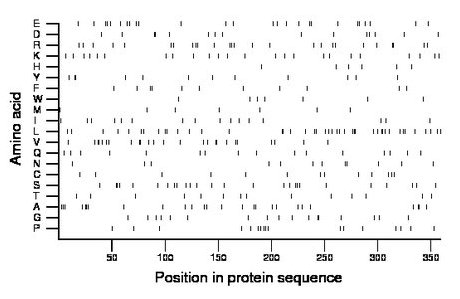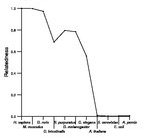
| Name: MAB21L2 | Sequence: fasta or formatted (359aa) | NCBI GI: 5453730 | |
|
Description: mab-21-like protein 2
|
Referenced in: Additional Genes in Development
| ||
|
Composition:

Amino acid Percentage Count Longest homopolymer A alanine 7.2 26 2 C cysteine 3.6 13 1 D aspartate 4.2 15 2 E glutamate 7.2 26 1 F phenylalanine 3.1 11 1 G glycine 4.7 17 2 H histidine 1.7 6 1 I isoleucine 4.5 16 1 K lysine 6.7 24 1 L leucine 12.0 43 3 M methionine 1.9 7 1 N asparagine 3.3 12 2 P proline 4.7 17 1 Q glutamine 4.5 16 1 R arginine 7.2 26 2 S serine 7.2 26 2 T threonine 3.9 14 1 V valine 7.0 25 2 W tryptophan 1.9 7 1 Y tyrosine 3.3 12 2 |
Comparative genomics:
Search single species RefSeq proteins at NCBI
Search summary 
Figure data | ||
Related human proteins:Protein Relative score Description Self-match 1.000 mab-21-like protein 2 MAB21L1 0.953 mab-21-like protein 1 C1orf161 0.106 hypothetical protein LOC126868 C6orf150 0.074 hypothetical protein LOC115004 C3orf59 0.043 hypothetical protein LOC151963 ITPRIPL1 0.027 inositol 1,4,5-triphosphate receptor interacting pro... ITPRIPL1 0.027 inositol 1,4,5-triphosphate receptor interacting pro... ITPRIP 0.027 inositol 1,4,5-triphosphate receptor interacting pro... C2orf54 0.023 hypothetical protein LOC79919 isoform 1 ITPRIPL2 0.017 inositol 1,4,5-triphosphate receptor interacting pro... C2orf54 0.016 hypothetical protein LOC79919 isoform 2 SMCR7L 0.014 hypothetical protein LOC54471 TMEM102 0.010 transmembrane protein 102 SMCR7 0.007 Smith-Magenis syndrome chromosome region, candidate... SMCR7 0.007 Smith-Magenis syndrome chromosome region, candidate ... RASGRP4 0.006 RAS guanyl releasing protein 4 isoform a RASGRP4 0.006 RAS guanyl releasing protein 4 isoform d RASGRP4 0.006 RAS guanyl releasing protein 4 isoform c RASGRP4 0.006 RAS guanyl releasing protein 4 isoform b IRGC 0.006 immunity-related GTPase family, cinema SNX18 0.006 sorting nexin 18 isoform c SNX18 0.006 sorting nexin 18 isoform b ASCC3 0.006 activating signal cointegrator 1 complex subunit 3 i...Human BLASTP results (used to prepare the table) | |||
Gene descriptions are from NCBI RefSeq. Search results were obtained with NCBI BLAST and RefSeq entries. When identical proteins are present, the self-match may not be listed first in BLASTP output. In such cases, the table above has been reordered to place it first.
See About the Figures for the scoring system used in the figure above right. The same scoring system was used in the table of BLASTP results.
Guide to the Human Genome
Copyright © 2010 by Stewart Scherer. All rights reserved.
